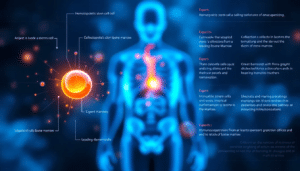If you’re one of the many people suffering from chronic back pain or neck pain caused by herniated discs, you know how debilitating it can be. Daily tasks become challenging. Sleep gets disrupted. Even sitting for long periods becomes uncomfortable.
The good news? You may not have to resort to spine surgery to find relief. Stem cell therapy offers significant pain relief for patients with herniated discs.
Thanks to advancements in regenerative medicine, there are now effective, minimally invasive options—like stem cell therapy—that are giving new hope to patients suffering from bulging and herniated discs. In this article, we’ll explain how stem cell for herniated disc treatments work, explore their benefits, and break down everything you need to know to make an informed decision.
What Is a Herniated Disc?
Your spine is made up of bones (vertebrae) and intervertebral discs that sit between them, acting like cushions. These discs help absorb shock and allow flexibility. A herniated disc happens when the annulus fibrosus, the tough outer layer of one of these cushions, tears or bulges, causing the inner gel-like nucleus pulposus to press against nearby nerves.
This can result in:
Severe pain
Tingling or numbness
Loss of mobility
Radiating pain in the arms or legs
Causes range from aging (degenerative disc disease) and injuries to years of wear and tear.
Understanding Herniated Discs and Degenerative Disc Disease

Herniated discs and degenerative disc disease are common conditions that affect millions of people worldwide. A herniated disc occurs when the soft, gel-like center of the disc bulges out through a tear in the outer, tougher layer. This can put pressure on nearby nerves, causing pain, numbness, tingling, and weakness in the back, arms, and legs. Degenerative disc disease, on the other hand, is a condition where the discs in the spine gradually deteriorate over time, leading to pain, stiffness, and limited mobility.
Conventional Treatment vs. Stem Cell Therapy
Traditional care usually includes:
Rest and physical therapy
Over-the-counter medications
Steroid injections
Eventually, spinal surgery if symptoms persist
But while these conventional treatments can manage symptoms, they rarely address the degenerative process or support disc regeneration. Conventional treatments often fail to address discogenic pain, which is a significant source of discomfort for many patients.
That’s where stem cell therapy changes the game.
The Rationale of Cell Therapy for Intervertebral Disc Regeneration
Cell therapy, also known as regenerative stem cell therapy, is a promising approach for treating herniated discs and degenerative disc disease. The rationale behind this therapy is to use stem cells to repair and regenerate the damaged disc tissue. Stem cells are undifferentiated cells that have the ability to differentiate into different cell types, including those found in the intervertebral disc. By injecting stem cells into the affected disc, the goal is to stimulate the body’s natural healing process and promote the growth of new, healthy tissue.
What Is Stem Cell Therapy for Herniated Discs?

Stem cell therapy is a type of regenerative treatment designed to help repair or restore damaged tissue in the body using undifferentiated cells—cells that can develop into other specialized types. In this case, they aim to help repair the damaged disc and reduce inflammation.
The most commonly used cells for this purpose are mesenchymal stem cells (MSCs), often derived from either:
Bone marrow
Adipose tissue (body fat)
These mesenchymal precursor cells are then concentrated and injected directly into the affected intervertebral disc.
The goal? Reduce inflammation, stimulate healing, and improve disc hydration and structure. Growth factors derived from the patient’s own cells play a critical role in this process, promoting healing, reducing inflammation, and supporting the regeneration of injured tissues.
How Stem CellsCan Help
Stem cells, commonly found in bone marrow and adipose (fat) tissuefrom bone marrow are a type of mesenchymal stem cell that can be used for intervertebral disc regeneration. These cells have the ability to differentiate into cells that produce the extracellular matrix, which is the main component of the disc. By injecting these types of stem cells into the affected disc, the goal is to stimulate the growth of new tissue and promote the repair of damaged disc tissue.
Types of Stem Cell Therapy and Administration Methods
There are several types of stem cell therapy that can be used for intervertebral disc regeneration, including autologous stem cell therapy, allogenic stem cell therapy, and xenogeneic stem cell therapy. Autologous stem cell therapy involves using the patient’s own stem cells, which are harvested from the bone marrow or adipose tissue. Allogenic stem cell therapy involves using stem cells from a donor, while xenogeneic stem cell therapy involves using stem cells from a different species. The administration methods for stem cell therapy include injection into the affected disc, injection into the surrounding tissues, and intravenous injection.
How the Treatment Works
Here’s what the process generally looks like:
Consultation & Imaging Your condition is assessed using diagnostic tools like magnetic resonance imaging (MRI) to confirm the presence of a herniated disc, disc protrusion, or signs of disc degeneration.
Harvesting ProcedureStem cells are collected from your own adipose tissue or bone marrow using a quick, in-office harvesting procedure.
InjectionThe concentrated stem cells are administered through a stem cell injection directly into the target disc. No general anesthesia or long hospital stay is required.
RecoveryAs a minimally invasive alternative to surgery, patients typically resume light activity shortly after treatment, with gradual improvement over several weeks.
What the Research Says
Several clinical trials and systematic reviews have shown promising outcomes when it comes to stem cell treatment for disc herniation and intervertebral disc degeneration:
Patients reported lower pain levels
Improved disc height and hydration
Reduced inflammation around surrounding tissues
Regrowth of extracellular matrix
Overall disc regeneration
In animal studies, these treatments have even reversed signs of degenerative changes, and most patients in human trials saw significant improvements in both pain and function compared to a control group. These studies have documented significant changes in patients’ pain scores and overall disc health.
Benefits of Stem Cell Therapy for Herniated Discs
Here’s why more patients are choosing stem cell for herniated disc treatment over traditional options:
Minimally invasive: No incisions or hospital stays
Natural healing: Uses your own regenerative cells
Low risk: Considered a safe procedure
Reduce pain: Targets inflammation at the source and helps alleviate discomfort
Improved function: Many patients regain mobility and comfort
Avoid surgery: No need to jump straight to high-risk spinal surgery
Are There Risks?
As with any medical treatment, there are some potential risks, though rare. These may include:
Temporary discomfort at the injection site
Inflammation or swelling post-injection
In very rare cases, infection
However, the treatment is widely considered safe, especially when performed by experienced specialists using sterile techniques.
Cost and Insurance Coverage for Stem Cell Therapy
The cost of stem cell therapy for intervertebral disc regeneration can vary depending on the type of therapy, the location, and the provider. On average, the cost of stem cell therapy can range from $5,000 to $20,000 or more per treatment. Insurance coverage for stem cell therapy is limited, and most insurance companies do not cover this type of treatment.
However, some insurance companies may cover certain aspects of the treatment, such as the harvesting of stem cells or the administration of the therapy. It is essential to check with your insurance provider to determine the extent of coverage.
At stem Cells LA we offer special rates on cash payments. Get in touch with our team to find out more.
Is Stem Cell Therapy Right for You?
This treatment may be a fit if:
You’ve been diagnosed with a herniated disc, bulging disc, or degenerative disc disease
You want to avoid the risks of spine surgery
You’re looking for a more natural, non-surgical approach
You’ve already tried conventional treatments with limited success
Every case is unique, so a personalized consultation is the best way to find out what’s right for you.
Why Choose Stem Cells LA?
At Stem Cells LA, we specialize in regenerative stem cell therapy that’s customized to your body and your needs. Our team stays at the forefront of intervertebral disc regeneration science, using advanced methods to treat disc damage and promote long-term recovery. Our regenerative therapy techniques are designed to provide optimal outcomes for patients.
We’re committed to giving our patients detailed, trustworthy care from diagnosis to post-treatment follow-up—and we never push unnecessary procedures.
Take the Next Step Toward Relief
You don’t have to live with constant pain. If you’re looking for real answers and a possible alternative to invasive surgery, stem cell therapy may be the solution you’ve been searching for.
👉 Schedule your consultation at stemcells.la or call us today at (310) 281-6160.
Let’s explore the safest, most effective path to your recovery—together.


